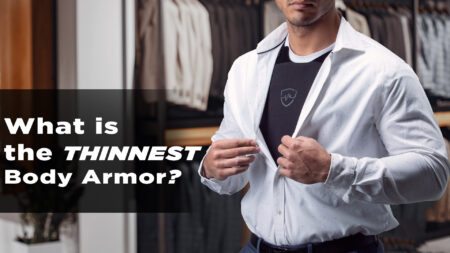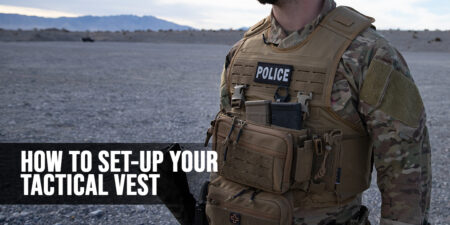Body armor is a literal life-saver. Hundreds of cops have been saved by their body armor since it became standard equipment for uniformed officers. Citizens are also beginning to recognize the value of body armor in self-defense situations.
This article will discuss plate carriers. You’ve probably heard the term and seen some on YouTube, but we will break it down for you. Starting with what a plate carrier is, we’ll talk about armor, move onto essential items you need on your plate carrier, and how to get the most out of it.
So, what is a plate carrier? In short, it is the item that holds hard armor plates, while also allowing attachments for various accessories. Plate carriers typically consist of a front armor panel and a back panel, allowing front and back protection of vital organs. A shoulder strap over each shoulder will hold the carrier in place, and most also have a cummerbund. The cummerbund tightens around the wearer’s midline, again, securing the carrier in place. You’ll even find some cummerbunds that allow users to run side armor plates, too.
A good plate carrier should also hold the armor firmly in place, preventing it from shifting during movement or uncommon body positions. It should do this while remaining flexible and permitting free and relatively easy movement, and actions like shouldering a rifle.
Understanding Plate Carriers
Plate carriers come in many different styles based on the different needs of users. Probably the most common type are tactical plate carriers. These are meant to be worn overtly, over the clothing. They are often covered with MOLLE webbing to allow the attachment of spare magazine pouches, medical gear, radios, less-lethal tools, an admin pouch, and other tactical gear. This provides immediate, easy access to mission-essential, lifesaving gear.
Some plate carriers are meant to be concealed. These low-profile plate carriers are cut down to the bare minimum. They typically lack any MOLLE attachment points that could print under a cover garment. The main goal of these is to provide ballistic protection without being noticed. These are commonly worn by plainclothes police officers, security guards, and personal security details. The benefit of these is their flexibility; they can go from low-visibility to a more aggressive posture simply by throwing on a chest rig containing mission-essential kit.
And of course, there are plenty of options between a full-on tactical plate carrier and a concealable plate carrier. Minimalist plate carriers are a good example. These carriers are worn overtly but carry only the essential gear for the mission, typically extra magazines, radios, and medical gear. Placards (clip-on mission configurable chest rigs) are being integrated with the minimalistic plate carriers, allowing users to change their kit as fast as they change their weapon platform.
Types of Body Armor
There are two basic types of armor you can wear: soft armor and hard armor. Soft armor is what most cops wear under their uniforms. The best soft body armor available is Safe Life Defense’s Hyperline body armor. It exemplifies everything that is desirable about soft body armor. Hyperline armor is thin, lightweight, and flexible. It is cool and comfortable, and despite all this, provides outstanding ballistic protection. It is NIJ Level IIIA-rated, meaning it will stop high-velocity pistol bullets like 9mm, .357 Magnum, and .44 Magnum, as well as shotgun buckshot.
Hard armor plates offer increased protection with some tradeoffs. Hard armor plates will stop rifle rounds. Level III hard armor plates will stop bullets up to 7.62×51 (.308 Winchester). This is a massive increase in protection, associated with the downsides of being bulkier, heavier, and rigid. This isn’t always the case; Safe Life Defense’s FRAS (Flexible Rifle Armor) breaks all the rules. It is soft, lightweight, and thin, while still providing ballistic protection that exceeds NIJ Level III when worn in conjunction with Hyperline soft body armor.
The ultimate in protection is the Level IV plates. Safe Life Defense’s Level IV plates will stop armor-piercing rifle rounds from high-power cartridges like .30-06 and 7.62x54R when worn in conjunction with Hyperline soft body armor. It is up to you to determine if this level of protection is necessary. For military personnel it absolutely is. Law enforcement officers may or may not need it, depending on their role. A citizen defending his or her home could probably go for something lighter, and save some money at the same time, but again this is personal preference.
Side plates can also provide rifle protection to the vulnerable flanks. Your sides are not protected with typical armor – a huge gap in protection. The lightweight, flexible FRAS Side Plates offer the protection of steel plates while being far more comfortable.
Essential Items for Plate Carrier Setup
The plate carrier is so popular because it is a gear organizer’s dream. You pull it over your head, fasten the cummerbund or waist strap, and boom – you’re ready to go. This is great for folks that may have to gear up at a moment’s notice. This includes the cop who is off-duty but on call, the soldier standing by for a QRF mission, or the citizen who hears a bump in the night.
Once you have your plate carrier and have decided on your armor, it is time to look at how to set it up. This requires deciding what you want on the carrier…and what you don’t. It is easy to overload a plate carrier, or put things in sub-optimal locations. Determining what accessories, you need depends on your mission. First, what is your job? Are you a citizen defending your home? If so, you will probably need less stuff than an Army Ranger fast-roping into a war zone in Afghanistan. Are you a cop, with rigid requirements about what you carry? All of these considerations will make a difference.
It is safe to say that just about anyone with a plate carrier needs extra magazines. The magazine pouches you choose will reflect the firearm(s) you are using. Since bullets may be flying when you don the plate carrier, medical gear is also a really good idea. Beyond that, most gear is on a case-by-case basis depending on your mission.
Police officers are going to need certain items, like handcuffs, that a citizen self-defender or soldier will not. Soldiers are going to need items like breaching shotguns and grenades that aren’t applicable to citizens back home. The average citizen defending his or her home? Outside of spare magazines and medical gear, a handheld flashlight, a less lethal option, and an admin pouch for carrying your cell phone are all really good ideas.
Setting Up Your Plate Carrier
Now let’s talk about plate carrier setup, starting with armor. You should adjust it so that your armor covers your vital organs. This means that your front plate should be nice and high. Usually this means positioning it so the top edge is just below your collarbones. High placement like this protects the boiler room: the heart, major vessels, and lungs. The rear plate should also be nice and high, and cover the same areas, but from behind. When tightened down it should prevent the armor from moving, but not prevent you from moving.
Next, you should begin slowly adding the gear you have already determined to be necessary. Start with the easy access items first: magazines and medical equipment. You should be able to get to these instantly, with either hand. Yes, it’s important to be able to get to everything, but these are the items that can potentially save your life when fractions of a second count.
Stuff that you may need, but not in a matter of seconds can go elsewhere. Water bladders and radios can go on your back (assuming your radio mic can be routed over your shoulder, of course). Add additional gear as necessary and depending on its priority.
As a general rule, it’s a good idea to keep gear on your tactical vest to minimum. The less stuff on your body, the less bulky you are. The less bulky you are, the easier you can fit through narrow confines and get into the prone position. The closer your gear is to your body, the less chance it is to snag on something, and the lighter it is, the less it impacts your center of gravity. Less gear equals less weight which means your energy goes further. These are all important considerations should a fight go hands-on, too.
Maximizing Plate Carrier Setup
Once you have your gear setup, do a few practice sessions at the range with it. Make sure it works the way you thought it would (hint: you’ll probably have to make some adjustments). Get your heart rate up, checking to see if it stays in place, or is too tight and restricts your breathing. Make sure you can access mags and medical gear standing, kneeling, prone, and supine. Once you’ve gotten everything where you want it, you’re almost done.
But not quite. Your plate carrier should be as streamlined as possible. Go through all your straps and make sure nothing is hanging loose. If there are loose straps, cut them and burn the edges, or tape them up. Make sure everything is secure, and nothing is coming loose. Now your plate carrier is fit to fight and will serve you well.
Shop Safe Life Defense for high-quality Plate Carriers!
A properly configured plate carrier will provide you with a ton of benefits. It will protect your vital organs from gunfire and stab wounds. It will keep your gear instantly accessible in the event of an emergency. And plate carriers are almost infinitely configurable to meet your specific needs. Safe Life Defense offers a full spectrum of best-in-class body armor to meet any need.






